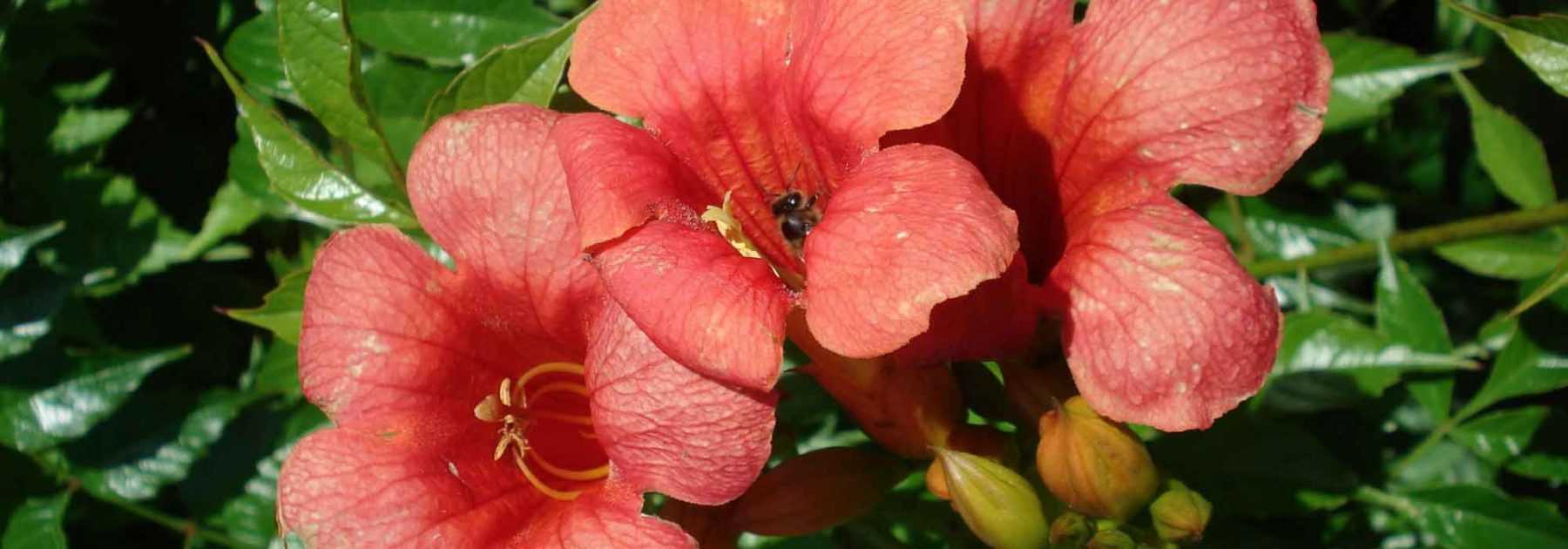
Trumpet Vine: Planting, Pruning, Propagating
Contents
The Trumpet Vine in a Nutshell
- The trumpet vine is a climbing plant that flowers from May to October
- Its trumpet-shaped flowers, in orange, yellow or red, have an exotic charm
- Like ivy, it’s a vigorous vine that clings on its own
- Undemanding, it’s easy to grow in mild climates
- It only fears severe frosts
Our expert's word
Less temperamental than a clematis, as vigorous as a wisteria, the Trumpet Creeper or Campsis, sometimes called the “Trumpet of Jericho“, is an original and vigorous climbing plant. In the garden, it is prized for its exuberant, bright orange flowering throughout summer and its attractive semi-evergreen foliage in mild winters. The display is magical from June to September-October!
Generous in growth, the Trumpet Creeper can quickly reach heights of 8 to 10 metres at maturity.
Typically orange-red, the flowers of newer cultivars showcase salmon-orange hues like ‘Indian Summer’, or vibrant red ‘Stromboli’, creating stunning garden displays.
Full of vigour, its stems cling unaided to any available support, quickly transforming even the simplest structure into a lush tableau. It is ideal for covering walls, pergolas and fences or climbing up trees.
This exotic-looking twining vine is easy to grow in mild climates or coastal areas, though it can withstand short periods of frost, typically down to -10°C, sometimes even lower if south-facing and mulched in winter.
It adapts to most soils that aren’t too dry and requires very little maintenance, only fearing severe frosts.
From cuttings to pruning, discover this beautiful climbing flower that charms with its originality and prolific blooming!
Description and botany
Botanical data
- Latin name Campis
- Family Bignoniaceae
- Common name Bignone, Trompette de Jéricho
- Flowering de mai jusqu’à l’automne
- Height 2 à 10 m
- Exposure Soleil, mi-ombre
- Soil type Tous, bien drainés
- Hardiness -10°C à - 15°C selon les variétés
The Trumpet Vine or Campsis, commonly called “Trumpet of Jericho” from the Bignoniaceae family, comprises vigorous climbing plants native to the warm, dry forests of the southeastern United States, China, and North America.
Formerly classified in the Bignonia genus, it now belongs to the Campsis genus, which includes about 120 genera and 725 species. The Bignonia genus now contains only one species, Bignonia capreolata.
Among the most widespread species in our gardens are Campsis grandiflora, the large-flowered trumpet vine with its wide, flaring orange-red trumpet-shaped flowers, though it offers few clinging tendrils; Campsis radicans, the common trumpet vine or Virginia trumpet vine (also nicknamed “Trumpet Jasmine”), which clings very easily; Bignonia capreolata, also called the Crossvine, with its long, fragrant trumpets; Campsis (x) tagliabuana, a hybrid between Campsis radicans and Campsis grandiflora; and the Pink Trumpet Vine (Podranea ricasoliana), a large scrambling shrub to train, native to South Africa and Zimbabwe.
Many varieties and hybrids have been developed, such as Campsis radicans ‘Indian Summer’, a very hardy Campsis.
The trumpet vine is a woody-rooted liana with rapid to explosive growth (1 m per year), capable of forming a beautiful, bushy plant 8 to 10 m tall in just a few years, sometimes even larger. This vigorous climber develops aerial roots to anchor itself to supports. Depending on the species, the plant clings more or less easily using its strong, twining stems with branched tendrils that adhere to surfaces like powerful crampons, similar to ivy.
Its deciduous or evergreen foliage in mild climates, abundant and lush, enhances the exotic colours and voluptuous shapes of the flowers. Borne on stiff stems, the leaves are opposite, sometimes up to 25 cm long, pinnate, oblong to lanceolate, finely divided into toothed or crenelated leaflets. In most species, the upper two leaves end in fine tendrils, allowing the plant to cling.
Bright green to dark green, sometimes yellow on the underside, it takes on purplish hues in winter in Campsis capreolata or turns magnificent golden-yellow shades in autumn.
The foliage is almost entirely hidden beneath the avalanche of flowers. The Trumpet Vine is one of the most spectacular decorative climbers for the summer season. The warm-coloured blooms are abundant from the first years of cultivation. Very long-lasting, it flowers all summer and can begin as early as April south of the Loire, continuing into autumn depending on the climate; flowering is optimal in mild climates.
The bushy growth is adorned with a profusion of wide trumpets flaring into 5 lobes. Measuring 4 to 8 cm long (up to 10 cm in diameter for the large-flowered varieties), they unfold in dense clusters or large panicles, with two to over 20 flowers at the ends of secondary branches.
Vivid tangerine orange, golden yellow, scarlet to vermilion red, fading to apricot, salmon pink, sometimes bicoloured or streaked with red-orange, these corollas sometimes emit a unique fragrance, reminiscent of both chocolate and roasted coffee.
Each flower reveals a beautifully contrasting throat where long stamens nestle. This flowering is followed by the formation of elongated green pods containing the Trumpet Vine seeds.
Campsis is a sun-loving climber! Very easy to grow, it thrives in any deep, well-prepared soil, even chalky, moist, and well-drained. Hardy down to -10°C (down to -15 to -20°C for Campsis radicans), it needs a sunny, sheltered position away from cold winds and draughts to flower well.
The trumpet vine is the perfect plant for covering a wall, an unsightly fence in a sunny spot, a tree trunk, or simply dressing up an arbour or pergola. Left untrained, it can also form an unusual ground cover.
Some more compact varieties can succeed in large containers to brighten up patios and balconies.
Main species and varieties
This genus includes few climbing species, and the most commonly cultivated in our gardens is Campsis grandiflora or the Large-flowered Trumpet Vine, the best-known of the genus with its clusters of trumpet-shaped flowers, 8 to 10 cm in diameter, scarlet or orange. Another is Campsis radicans, the “Virginia creeper,” with long yellow, red, or orange trumpets, which clings very easily to any support.
You can also find hybrid Trumpet Vines (Campsis (x) tagliabuana and the Summer Jazz® series), selected for their compact growth, making them ideal for small spaces and container gardening, their excellent cold resistance, and their exceptional flowering.
Bignonia capreolata is a less hardy species (-5°C) with a fragrant bloom that can reach up to 20 m in height in the wild.
There are many cultivars with blood-red flowers, such as Campsis radicans ‘Stromboli’, or more compact and hardier varieties like ‘Indian Summer’, or even bicoloured ones like ‘Orangeade’.
The main selection criteria are flower colour, mature height, and hardiness, which varies by variety.
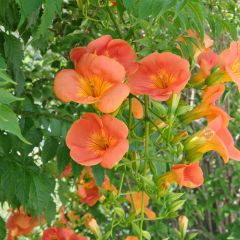
Campsis grandiflora
- Flowering time September to November
- Height at maturity 7 m

Campsis radicans Indian summer
- Flowering time July to October
- Height at maturity 3 m

Campsis radicans x grandiflora Madame Galen
- Flowering time August to October
- Height at maturity 10 m

Campsis x tagliabuana Summer Jazz Gold
- Flowering time August to October
- Height at maturity 3 m

Campsis radicans Stromboli - Trumpet Vine
- Flowering time August, September
- Height at maturity 4 m

Campsis capreolata Tangerine Beauty
- Flowering time June to October
- Height at maturity 8 m

Campsis radicans Flamenco
- Flowering time September to November
- Height at maturity 8 m

Campsis radicans Yellow Trumpet
- Flowering time August to October
- Height at maturity 6 m
Discover other Campsis - Trumpet Creeper
View all →Available in 1 sizes
Available in 1 sizes
Available in 3 sizes
Available in 2 sizes
Available in 1 sizes
Available in 1 sizes
Available in 1 sizes
Available in 1 sizes
Available in 1 sizes
Available in 1 sizes
Planting
Where to Plant Trumpet Vine
Although it has fairly good cold resistance, withstanding temperatures down to -10°C on average, sometimes more depending on the species and growing conditions, Trumpet Vine is best suited to regions with relatively mild winters. It’s a vigorous plant but should be protected from severe frosts and icy winds. The Summer Jazz® series of trumpet vines are more cold-resistant.
In colder regions, it must be planted in a sheltered south-facing position, along a well-exposed wall or against a tree, protected from cold, drying winter winds which can damage flowering and cause premature bud drop. Be careful not to plant trumpet vine near pipes: its powerful root system can damage plumbing.
In sheltered positions, the plant will regrow from the base after frost damage. It tolerates coastal salt spray well.
It needs full sun to flower well. In southern areas, it will tolerate partial shade. Campsis radicans ‘Indian Summer’, hardy to -15°C, performs best in partial shade in less sunny regions north of the Loire.
Not fussy about soil type, it adapts to any good garden soil, well-drained, even chalky, but not too wet: it dislikes heavy, compacted or waterlogged soils. However, it prefers fertile, reasonably deep soil. It likes soil that stays cool, but as it matures will tolerate occasional summer dryness. In fertile, cool soil, its growth will be much faster and flowering very abundant.
Trumpet Vine has many uses in mild climate gardens. With growth ranging from fast to slow depending on variety, it makes an excellent wall cover. It suits all gardens, even small ones, depending on the variety.
When not trained on a support, it can form an attractive bushy mass over a low wall or slope where it creates an unusual ground cover.
→ Discover why your trumpet vine isn’t flowering!
When to Plant Trumpet Vine?
Plant Trumpet Vine in spring, from March to May, or in autumn in mild climates.
How to Plant Campsis?
- In open ground
To cover a well-exposed wall or fence, space Trumpet Vine plants 3 to 4m apart, otherwise allow 1-2m spacing from other plants. Most trumpet vines (except Campsis radicans which develops strong enough holdfasts to climb unaided) need trellis or staking for initial support. If your garden soil is too heavy, add gravel to the planting hole.
- Dig a hole 3 times wider than the rootball
- Make a small mound at the base with some excavated soil to support roots
- Add gravel for perfect drainage
- Position plant centrally with crown at soil level
- Backfill with excavated soil mixed with compost
- Firm gently with your foot
- Mulch around the base
- Water regularly until established
- Training as a standard
Some trumpet vines (Podranea ricasoliana) can be trained as standards like wisteria, useful for container growing.
- Train the strongest stem up a sturdy stake
- Remove side shoots up to desired height to form a trunk
Container Growing
Some more compact, hardy varieties like Trumpet Vine Indian Summer or hybrids (Campsis x tagliabuana ‘Summer Jazz Fire’) suit small spaces and container growing. Plant in a well-draining mix of leaf mould, garden soil and coarse sand. Fertilise regularly, repot every 3 years and prune to control growth. Keep soil moist in summer, mulch heavily in winter or move pots to frost-free shelter in cold regions.
→ Learn more about growing trumpet vine in containers in our guide
Care and maintenance
Low-maintenance, the Trumpet Creeper requires very little care, only fearing severe frosts. It simply needs protection from the cold during the first few years of growth. That’s its only weakness!
Train the young shoots as they grow, helping them cling to their support until the plant can do so unaided.
Water regularly during the first few summers.
Keep the base cool with ground-covering perennials or mulch, especially during prolonged dry spells and for the first 3 years after planting. Once established, it will tolerate drought well.
Refresh the mulch before winter; in the early years, protect the base from heavy frosts.
In spring, add a thick layer of compost around the base to encourage flowering and maintain soil moisture.
Potted trumpet creepers need regular fertiliser and watering during the growing season. In winter, protect the pot or move it to shelter.
Repot every 3 years if the plant shows signs of exhaustion.
Pruning Trumpet Vine: When and How
Pruning isn’t essential, but it may prove necessary if your trumpet creeper becomes invasive – this is a vigorous plant whose growth sometimes needs restraining! Pruning helps maintain a compact, balanced shape, encourages growth and stimulates flowering. Annual pruning will also prevent the plant from becoming bare at the base.
When to prune?
Prune your trumpet creeper in late winter, between February and March, before new growth begins. In August-September, simply remove spent flower stems. Avoid pruning in autumn.
How to prune?
The harder you prune, the more vigorous and floriferous your trumpet creeper will be! If the branches have died back in their upper third – a normal occurrence – it’s time to prune.
- Using secateurs, remove frost-damaged tips, crossing branches, weak growth or dead wood at the base, keeping only the strongest stems
- Cut back the previous year’s growth to 3 or 4 buds from the main stem (about 40cm)
- Prune leaving a few buds on each stem
- If necessary, you can cut back severely without issue
→ Learn more about pruning trumpet creepers with Virginie’s advice, and about training trumpet creepers as trees in our tutorial. If your trumpet creeper has become invasive, discover Alexandra’s tips for removing an overgrown trumpet creeper.
Pests and potential diseases
Trumpet Creeper is rarely diseased and shows good resistance. Mealybugs, aphids, red spider mites, white leafhoppers, and powdery mildew are its main enemies. These attacks are rarely serious.
Recognisable by the white cottony clusters they leave on leaves, mealybugs can be removed with cotton soaked in 90°C alcohol, followed by sprays of rapeseed oil to be repeated two or three times at 15-day intervals.
Sprays of soapy water may be enough to dislodge aphids.
Against red spider mites, common in summer, spray a nettle infusion.
Trumpet creepers are often heavily visited by ants, usually without harm to the plant.
→ Learn more about diseases and pests of the trumpet creeper in our advice sheet
Propagating Trumpet Vine: How to Do It?
How to Take Cuttings from Trumpet Creeper?
Taking cuttings isn’t straightforward for amateurs as rooting takes quite a long time.
- After flowering, take semi-hardwood cuttings (beginning to turn woody) 3 to 5 cm long
- Insert them three-quarters deep into a light substrate (peat and river sand) that drains well, keeping it moist and spacing them 5 cm apart
- Place the tray or pot under a cold frame during winter
- Transplant them into open ground the following spring once they have sufficient roots
By Layering
While cuttings are possible, layering in spring remains, in our opinion, the simplest method.
- Dig a shallow trench in the soil near the parent plant
- Choose a non-flowering stem with tendrils that can be easily bent to the ground
- Bury the aerial parts under about 20 cm of soil
- Lift the tip of the stem and stake this aerial portion
- Fill in the trench and secure the layer
- Separate the layer from the parent plant once it has enough roots in autumn or the following spring
- Grow the layer in a pot for optimal establishment before planting out
→ Learn more about Trumpet Creeper propagation in Solenne’s tutorial
Pairing the Trumpet of Jericho
The trumpet vine is a vigorous climber that thrives when grown as a standalone plant, adding an exotic touch to any support provided. In gardens with mild climates, it can be grown against a wall where it will often flower more abundantly or trained to climb over large shrubs or small trees.
The more compact varieties (Campsis x tagliabuana) will form an extraordinary shrub in the middle of a flowerbed, becoming the focal point of a small garden.
Its typically orange-red flowers pair beautifully with warm colours and bronze foliage.
For more contrasting compositions, combine it with the blue flowers of Clematis viticella ‘Sunny Sky’, Sollya heterophylla, or a pretty morning glory.
While trumpet vines complement each other well, to create a vibrantly colourful display, pair them with other plants unusual climbers such as Akebia quinata, Actinidia kolomikta or ornamental kiwi, and Holboellia latifolia.
It pairs effectively with chartreuse foliage like ivy, hops and golden catalpa, as well as with a garnet-coloured ‘Cardinal’ clematis or purple vines.
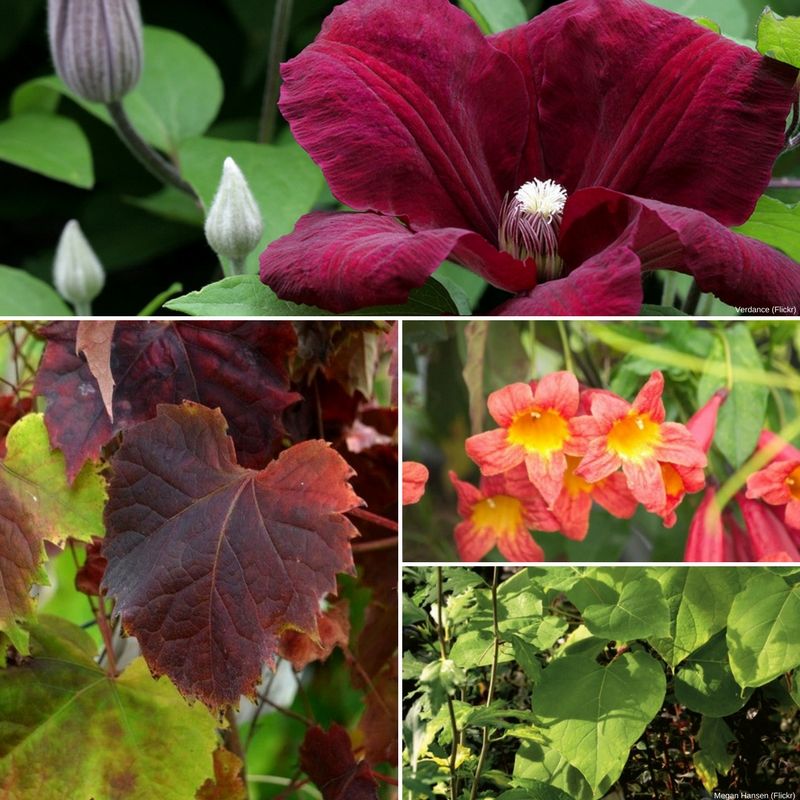

A beautiful planting combination: Clematis ‘Rouge Cardinal’ / Parthenocissus tricuspidata ‘Atropurpurea’ / Campsis capreolata ‘Tangerine Beauty’ / Catalpa bignonioides ‘Aurea’.
It will weave beautifully through an Eleagnus.
The autumn hues of a Cotinus or smoke tree will complement the colour of late-flowering Campsis radicans or Virginia trumpet vine.
At its base, you can plant perennials or small shrubs like woody sages, Cerastostigma with small blue flowers, daylilies, gauras, asters, or euphorbias.
Useful resources
- A collection of exceptional trumpet creepers? Discover our exclusives!
- Advice sheet: Choosing a trumpet creeper
- Advice sheet: Growing a trumpet creeper in a pot
- Tutorial: How to prune a trumpet creeper into a tree shape?
- Advice sheet: 5 trumpet creepers – the most beautiful varieties
- Advice sheet: 7 trumpet creepers: reliable choices
- Advice sheet: 7 hardiest trumpet creepers
- Advice sheet: Which trumpet creeper to plant according to your region?
Frequently asked questions
-
Why isn't my trumpet vine flowering? What could be the reasons?
The Trumpet Vine thrives in warmth and requires a very sunny position to flower well. It's possible that the current location isn't bright enough. Plant your trumpet vine against a south-facing wall to ensure good flowering.
Your soil may also be too rich in nitrogen, which encourages leaf growth at the expense of flowers. Finally, keep in mind that grafted specimens flower more quickly.
- Subscribe!
- Contents





































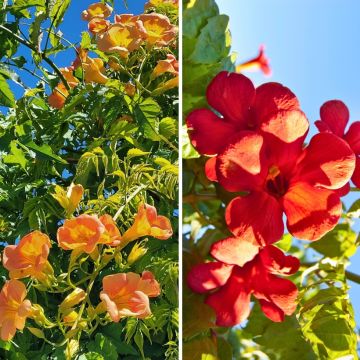
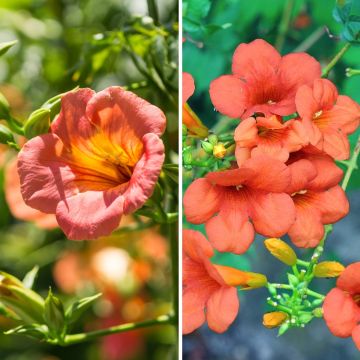
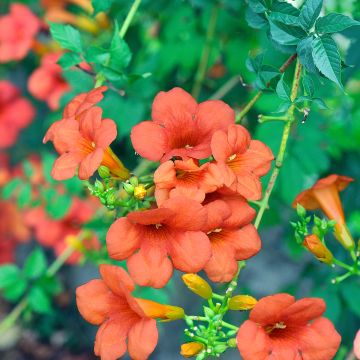
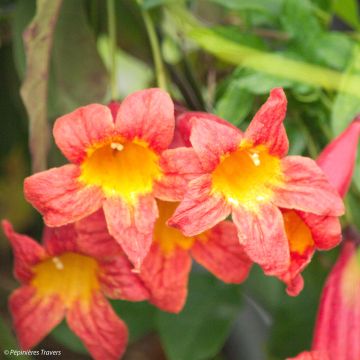
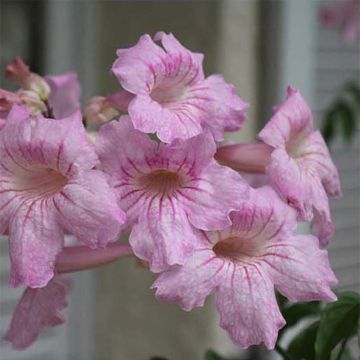

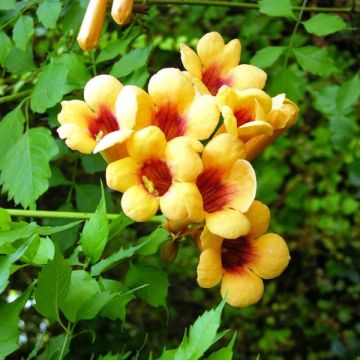

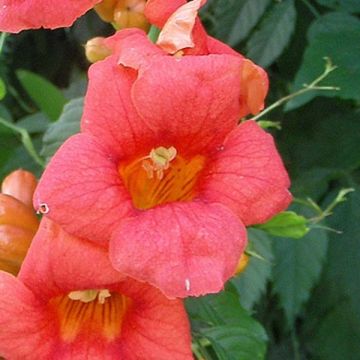
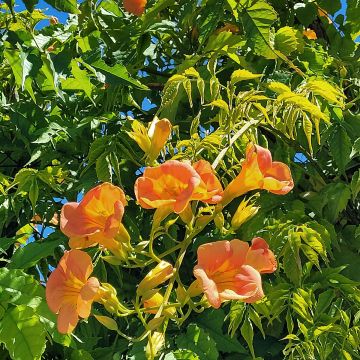

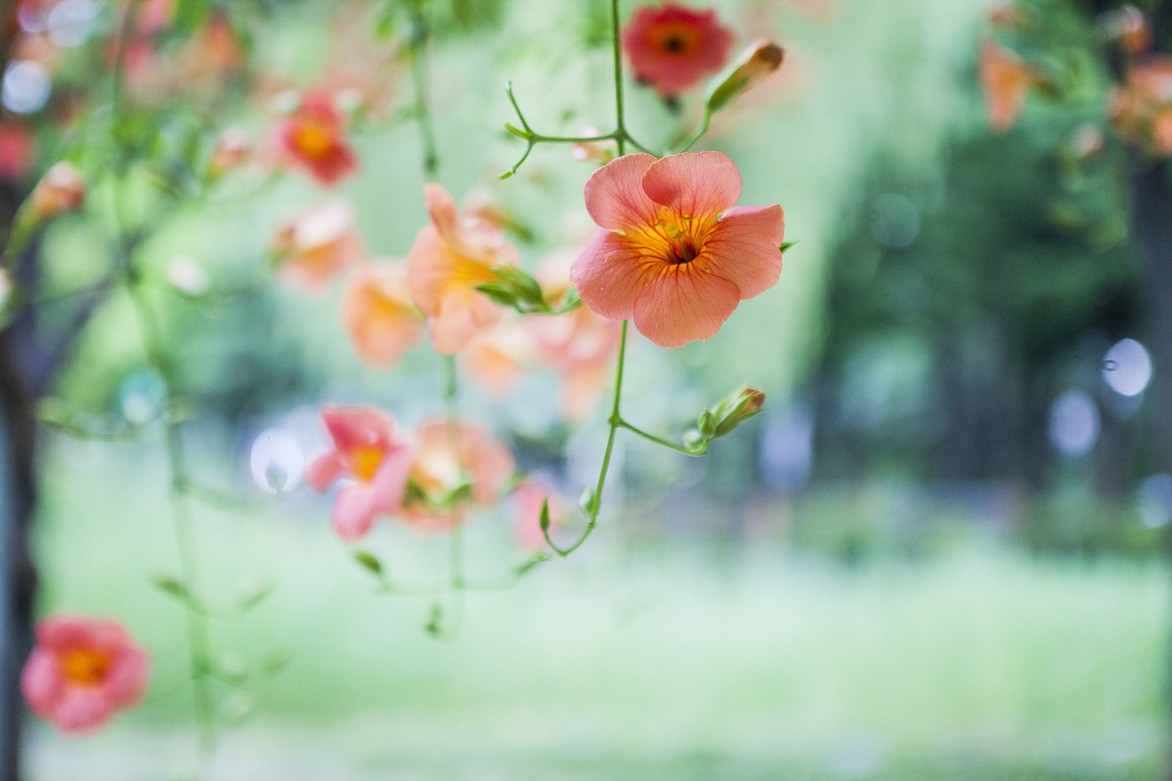

Comments